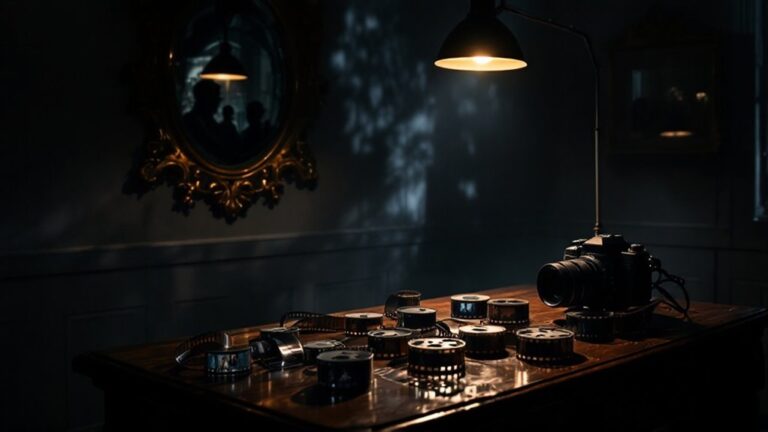How Nolan Builds Suspense in Films
Nolan builds suspense in his films through a masterful intertwining of nonlinear storytelling, emotional connections, and visual techniques. You’ll notice he often manipulates time, using fragmented narratives to create urgency and tension. Characters face relatable internal struggles, drawing you into their emotional arcs and heightening stakes. He employs unreliable narrators and shifting perspectives, leaving you questioning motives and outcomes. Visually, unconventional editing and striking imagery elevate anxiety, making every moment feel charged with potential dread. Each layer of complexity invites your reflection and engagement, compelling you to unravel the intricate tapestry he’s woven. There’s much more to uncover about his unique style.
Table of Contents
Key Takeaways
- Nolan employs nonlinear storytelling, intertwining multiple timelines to enhance suspense and challenge audience expectations.
- Unpredictable sound design and ticking clock elements amplify emotional stakes and urgency throughout his films.
- Characters often grapple with unreliable memories, creating uncertainty and heightening suspense around their motives and actions.
- Layered visual techniques, such as close-ups and muted colors, induce discomfort and anxiety, enhancing the overall tension.
- Intentional misdirection and withheld information require audiences to engage deeply, fostering intrigue and maintaining suspense.
Story Structure Techniques
When Nolan constructs his films, he meticulously employs story structure techniques that keep you on the edge of your seat. His use of scene sequencing is deliberate; by carefully ordering scenes, he enhances drama and challenges your assumptions. Nonlinear storytelling plays a pivotal role, as it allows him to present major twists that catch you off guard, keeping you engaged throughout. In films like “Inception,” individual scenes possess their own arcs of suspense, adding layers to the narrative. Nolan’s early work, particularly Following, showcases his ability to weave complex narratives that lay the groundwork for his later projects. The ticking clock creates a palpable tension, making you feel the urgency. Nolan’s knack for multiple perspectives further complicates the story, inviting you to piece together the puzzle, ensuring your emotional investment remains high as the plot unfolds in unexpected ways. This approach, similar to Hitchcock’s emphasis on information to create suspense, deeply engages the audience by keeping them aware of the impending dangers faced by characters.
Time Manipulation Strategies

Nolan’s storytelling techniques naturally evolve into a fascinating exploration of time manipulation strategies that heighten emotional impact.
By employing time inversion, he allows characters to navigate cause and effect in unexpected ways, creating a sense of urgency and tension. This constructed illusion of time enhances the viewer’s experience, deepening their engagement with the narrative. Nolan’s approach to nonlinear narratives adds layers of complexity that challenge audience comprehension.
This narrative fluidity not only enriches the plot but also emphasizes the cyclical nature of corruption and survival.
As you engage with his films, consider these key strategies:
- Time as a powerful weapon
- The struggle for understanding time’s flow
- The manipulation of audience perception
- Non-linear storytelling that mirrors memory
- The emotional weight of fragmented narratives
In this intricate dance with time, Nolan invites you to experience the complexities of truth, identity, and the human condition, making each moment feel profoundly significant.
Visual Storytelling Elements
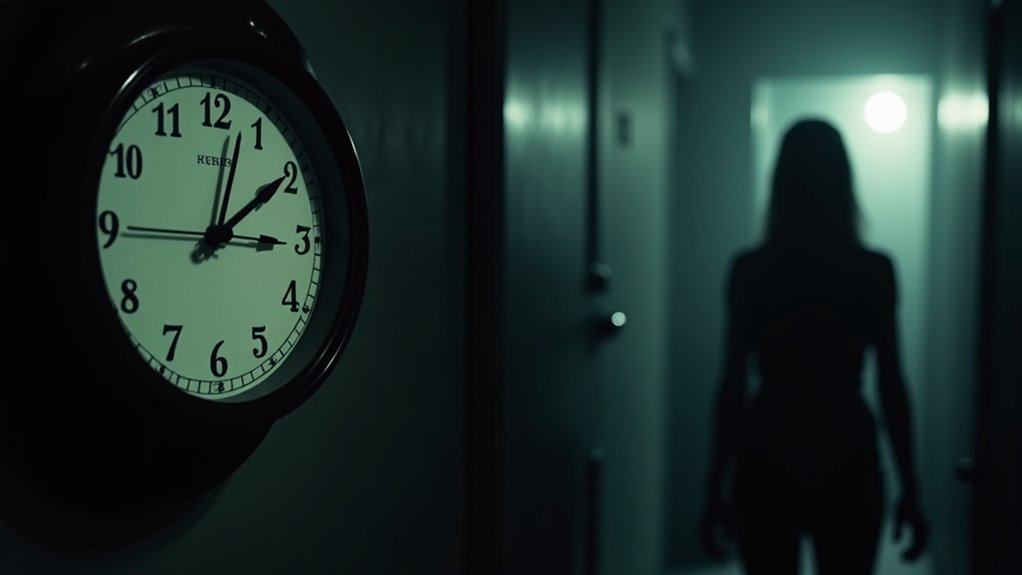
Visual storytelling elements play an essential role in how suspense unfolds in Nolan’s films. He expertly uses visual symbolism, such as shadows and muted color palettes, to create an atmosphere thick with tension. This aesthetic choice not only enhances the dramatic stakes but also emphasizes character isolation, making you feel the weight of their struggles. Nolan’s films often feature nonlinear storytelling that keeps viewers guessing and heightens the suspense of unfolding events. Additionally, his emphasis on complex puzzles engages audiences further, as they work to piece together the narrative. Nolan’s shallow depth of field isolates characters in wide close-up shots, drawing you into their emotional states. Hand-held camera work further immerses you in the narrative, blurring the lines between observer and participant.
Creating Tension and Anxiety
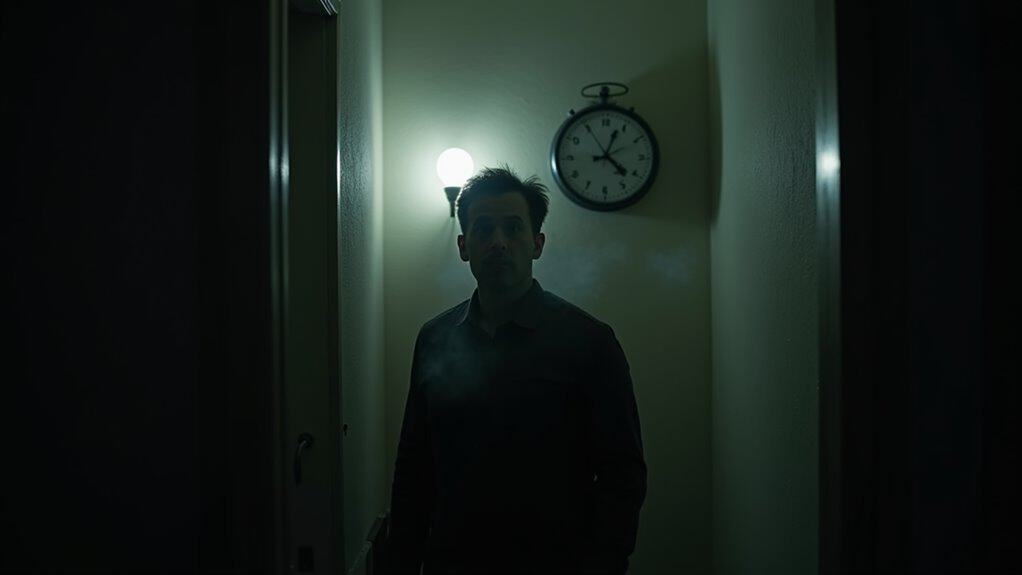
As you plunge into a Nolan film, the tension and anxiety are palpable, expertly crafted through his innovative cinematic choices. His techniques in tension creation and anxiety induction engage your senses, leaving you breathless.
- Unpredictable sound design heightens emotional stakes.
- Close-up shots create a sense of suffocation.
- Layering shots induce visual discomfort.
- Double exposure adds a surreal quality.
- Unconventional editing maintains a relentless pace.
These elements work in harmony, pulling you deeper into the narrative’s grip. Each unexpected auditory cue or disorienting visual contributes to an atmosphere where anxiety thrives. Notably, the film’s structure reflects the urgency of the Manhattan Project, amplifying the stakes as the story progresses, much like how Dunkirk’s non-linear storytelling creates disorientation that mirrors chaotic wartime experiences.
You find yourself on the edge of your seat, aware that every moment could lead to a startling revelation, ultimately drawing you into Nolan’s compelling world of suspense.
Effective Narrative Techniques

While watching a Nolan film, you quickly realize that effective narrative techniques play an essential role in building suspense. His use of non-linear storytelling, particularly through embedded narratives, captivates your attention and keeps you on the edge of your seat.
By intercutting scenes from various timelines, as seen in *The Prestige* and *Inception*, Nolan creates a rich tapestry of tension and intrigue. Shifting perspectives and unreliable narrators, especially in *Memento*, engage your curiosity, prompting you to piece together the puzzle.
Furthermore, the chronological complexity of his plots adds layers of suspense, challenging your assumptions about time and character motivations. This intricate storytelling not only heightens suspense but also invites you to reflect deeply on the unfolding drama.
Director’s Creative Intentions
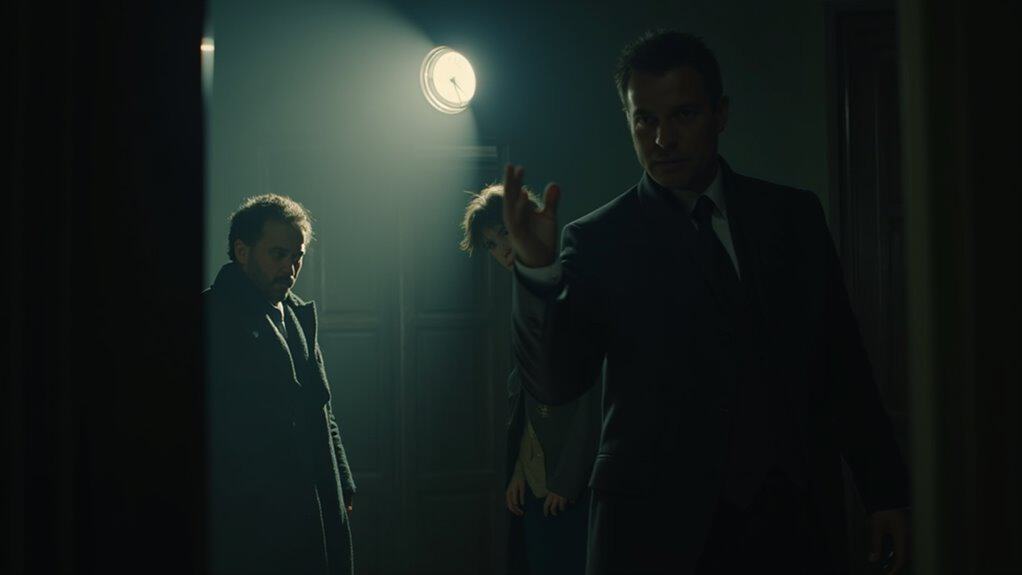
When you watch a Nolan film, you can’t help but feel immersed in a world where every twist and turn keeps you on the edge of your seat.
His unique narrative structures not only challenge your understanding of time and perspective but also draw you into an emotional labyrinth that resonates long after the credits roll.
Immersive Audience Experience
Nolan masterfully immerses audiences in his films, crafting a heightened sense of reality that keeps viewers on the edge of their seats. Through his use of practical effects and immersive soundscapes, you experience each scene as if you’re part of it.
- Practical effects create authenticity and evoke genuine reactions.
- Cinematic techniques, like hard-mounted shots, enhance realism.
- Hans Zimmer’s scores amplify emotional tension and narrative depth.
- Subjective camera views draw you deeper into characters’ experiences.
- Silence effectively heightens suspense, making you hold your breath.
Unique Narrative Structures
Suspense in Nolan’s films isn’t only created through immersive experiences but also by his unique narrative structures that challenge traditional storytelling. His narrative innovation includes genre manipulation and misdirection techniques, where you often find morally ambiguous characters and unexpected twists that keep you guessing.
Nolan’s use of non-linear storytelling, such as in *Dunkirk* and *Interstellar*, emphasizes multiple timelines and subjective experiences, enhancing suspense techniques. The circular narrative approach, featuring thematic consistency and bookending elements, ties the story together in an enthralling way.
Building Complexity With Timelines

While exploring complex narratives, filmmakers often turn to nonlinear storytelling to captivate audiences, and Christopher Nolan excels in this arena. His use of multiple timelines adds layers of narrative complexity, creating tension and intrigue.
Consider these techniques that enhance his storytelling:
- Multiple timelines intercutting for suspense
- Backward chronology reflecting character struggles
- Temporal fragmentation to vary pace
- Crosscutting that builds urgency
- Shifting perspectives increasing tension
Engaging the Audience Emotionally

In Nolan’s films, emotional character connections pull you into the story, making you care deeply about their journeys.
As you witness relatable conflicts and escalating stakes, you can’t help but feel a mix of empathy and fear for the characters’ fates.
This blend of emotional engagement not only heightens your investment but also amplifies the suspense, inviting you to experience every twist with bated breath.
Emotional Character Connections
Nolan masterfully engages audiences emotionally by weaving deep character connections into his narratives. His films often highlight the intricate character dynamics that elevate emotional stakes, making viewers invest in the characters’ journeys.
For instance, in Interstellar, the bond between Cooper and Murph underscores the film’s emotional core, reflecting love’s powerful, unseen force.
- Emotional arcs culminate in impactful crescendos.
- Props symbolize deeper emotional themes, enhancing connections.
- Relationships reveal profound insights into characters’ motivations.
- Emotional breakthroughs emerge from carefully crafted build-ups.
- Nolan’s nuanced approach avoids sentimentality, focusing on authentic experiences.
Through these elements, Nolan creates a landscape where viewers not only witness the story but also feel the weight of the characters’ struggles and triumphs.
Relatable Conflicts and Stakes
Engaging audiences emotionally hinges on relatable conflicts and stakes that resonate with their own experiences. Nolan’s characters often grapple with personal stakes, driven by relatable motivations rooted in loss, guilt, or existential questions. This connection fosters emotional investment, as you recognize pieces of your own struggles in their journeys.
| Film | Core Conflict | Relatable Motivation |
|---|---|---|
| *Memento* | Memory loss and obsession | Searching for identity |
| *The Prestige* | Rivalry and sacrifice | The quest for meaning |
| *Inception* | Reality versus illusion | Fear of failure in dreams |
Audience Empathy and Fear
Suspense thrives on the delicate interplay between audience empathy and fear, drawing viewers deeper into the narrative.
When you connect emotionally with characters, their vulnerabilities become your own, amplifying the tension as you experience their fears firsthand.
Nolan skillfully balances hope and dread, making you question what’ll happen next.
- You invest emotionally in characters’ fates.
- Their fears reflect your own, enhancing engagement.
- Unforeseen obstacles heighten suspense and uncertainty.
- Subjective storytelling immerses you in their reality.
- Emotional stakes make each moment pivotal.
Use of Unreliable Narrators
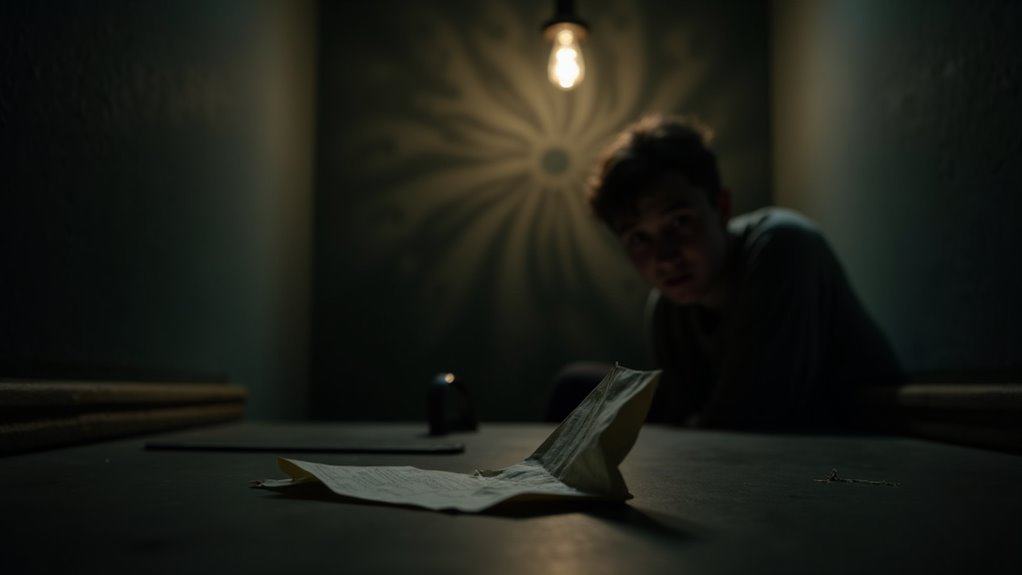
While many filmmakers experiment with narrative structure, Christopher Nolan’s use of unreliable narrators stands out for its ability to weave intricate layers of deception and tension into his stories.
In films like *Memento*, you encounter characters grappling with unreliable memories, forcing you to question their motives and perceptions. Nolan crafts suspense through intentional misdirection, where characters manipulate the truth, leaving you guessing.
As the story unfolds, key information is often withheld, making you piece together the reality from conflicting perspectives. These narrative twists create a complex web that deepens your engagement, as you become an active participant in deciphering the truth.
Ultimately, Nolan’s unreliable narrators not only heighten suspense but also challenge your understanding of reality itself.
Balancing Hope and Fear

In Nolan’s films, balancing hope and fear is essential for keeping you emotionally invested in the characters and their journeys.
By contrasting character outcomes, he creates a tension that makes you question whether they’ll find redemption or face despair, which heightens the stakes of their choices.
This emotional tug-of-war not only enhances the suspense but also invites you to reflect on the complexities of truth and illusion in their lives.
Emotional Investment Techniques
Creating a gripping emotional experience in films often hinges on the delicate balance of hope and fear. When you invest emotionally in characters, their journeys become more compelling.
Nolan expertly employs techniques that enhance this connection, allowing you to feel the stakes profoundly.
- Clear character motivations drive the plot.
- Emotional stakes increase as challenges arise.
- The audience connection deepens with relatable struggles.
- Suspense layering keeps you on the edge of your seat.
- Hope flickers amidst fear, creating tension.
Contrast in Character Outcomes
Suspense in Nolan’s films often hinges on the stark contrast in character outcomes, weaving a tapestry of hope and fear that keeps audiences engaged.
You witness character desperation escalate as moral dilemmas arise, forcing individuals to confront their inner conflicts. For instance, in *Inception*, characters grapple with the choice between personal desires and the greater good, amplifying the stakes.
This balance between hope and fear is palpable; you feel the tension as characters endeavor for escape while facing increasingly complex obstacles. The ambiguity of their fates, symbolized by elements like the spinning top, leaves you pondering long after the credits roll.
Ultimately, Nolan masterfully intertwines these elements, crafting narratives that resonate deeply and provoke thought about the nature of morality and choice.
Conclusion
In Nolan’s films, suspense thrives through intricate structures, time manipulation, and emotional engagement. He weaves tension with visual storytelling, balancing hope and fear, while crafting unreliable narrators that challenge your perception. As you navigate his complex timelines, you find yourself drawn deeper into the narrative, reflecting on your own anxieties and desires. Ultimately, Nolan’s mastery lies not just in creating suspense, but in inviting you to experience the thrill of uncertainty, where every moment counts, and every choice matters.


